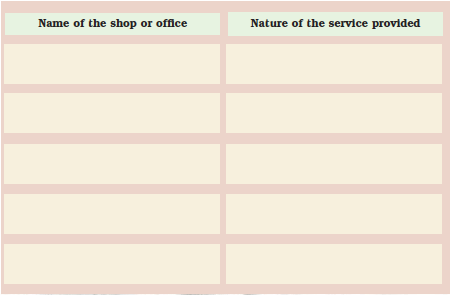Table of Contents
Chapter 9
Urban Livelihoods

1. What do you see in this illustration?
2. You have already read about the work that people do in rural areas. Now compare the work that people in this illustration are doing with the work that people do in rural areas.
3. Some parts of the city are different from others. What differences do you notice in this illustration?
There are more than five thousand towns and twenty seven big cities in India. Big cities like Chennai, Mumbai, Delhi, Kolkata etc. have more than a million people living and working here. They say that 'the city never sleeps!' Let's visit one and find out about the work people do in the city. Are they employed by someone or are they self-employed? How do they organise themselves? And do they have similar employment and earning opportunities?

Working on the Street
This is the city where my cousin lives. I've been here only a few times. It is very big. Once, when I came here, my cousin took me around. We left the house early in the morning. As we turned the corner onto the main street we saw that it was already buzzing with activity. The vegetable vendor was busy arranging tomatoes, carrots and cucumbers in baskets at her stall so that people could see what she had to sell. Next to her stall was a lovely, colourful one that sold all kinds of flowers.
We bought a red rose and a yellow rose. On the pavement opposite we saw a person selling newspapers with a small crowd of people around him. Everyone wanted to read the news! Buses whizzed past and there were auto-rickshaws filled with school-children. Nearby, under a tree, a cobbler sat taking his tools and materials out of a small tin box. Next to him the roadside barber had begun his work: he already had a customer who wanted an early-morning shave!
A little way down the road, a woman was pushing along a cart with all kinds of plastic bottles, boxes, hairpins, clips etc. in it while another person on a cycle trolley was carrying vegetables to sell to people in their houses.

We came to a place where rickshaws were standing in a row waiting for customers. We decided to take one to the market, which was about two kilometres down the road.
Bachchu Manjhi – A Cycle-Rickshaw Puller
I come from a village in Bihar where I worked as a mason. My wife and three children live in the village. We don't own land. In the village I did not get masonry work regularly. The income that I earned was not enough for our family.
After I reached this city, I bought an old cycle rickshaw and paid for it in instalments. This was many years ago.
I come to the bus stop every morning and take the customers wherever they want to go. I work till 8.30 in the evening. I take rides of up to 6 kilometres in the surrounding area. Each customer gives me Rs. 5-10 per trip depending on the distance. When I'm ill I can't do this work, so on those days I don't earn anything.
I stay with my friends in a rented room. They work in a nearby factory. I earn between Rs. 80-100 every day, out of which I spend Rs. 50-60 on food and rent. The rest I save for my family. I visit my village two or three times a year to see my family. Though my family survives on the money I send, my wife also earns from agricultural work that she gets once in a while.
1. Why did Bachchu Manjhi come to the city?
2. Why can't Bachchu Manjhi live with his family?
3. Talk to a vegetable vendor or hawker and find out how do they organise their work, their way of preparing, purchasing, selling etc.
4. Bachchu Manjhi has to think twice before taking a day off from work. Why?
Like Bachchu Manjhi a large number of people in the city work on the streets. In a survey of Ahmedabad city it was found that 12 per cent of all the workers in the city were people working on the street. They sometimes sell things or repair them or provide a service.
They work on their own. They are not employed by anyone and therefore have to organise their own work. They have to plan how much to purchase, as well as where and how to set up their shops. Their shops are usually temporary structures:
sometimes just some boards or papers spread over discarded boxes or maybe a canvas sheet hung up on a few poles. They may also use their own carts or simply a plastic sheet spread on the pavement. They can be asked to dismantle their shops at any time by the police. They have no security. There are certain parts of the city where these hawkers are not allowed to enter.
Vendors sell things that are often prepared at home by their families who purchase, clean, sort and make them ready to sell. For example, those who sell food or snacks on the street, prepare most of these at home.
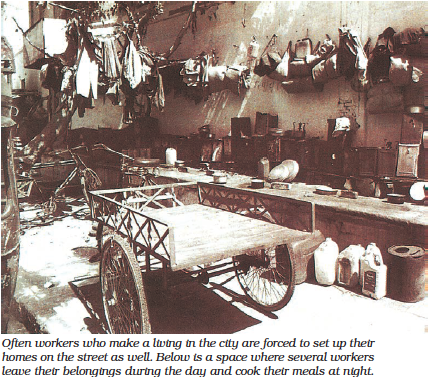
There are almost one crore 'street vendors' in the country working in urban areas. Street vending was till recently looked upon only as an obstruction to traffic and to people walking. However with the effort of many organisations it is now recognised as a general benefit and as a right of people to earn their livelihood. The government is thinking about modifying the law that banned street vendors, so that they have a place to work and that there is also a free flow of traffic and people. Hawking zones have been suggested for towns and cities. It has also been suggested that mobile vendors should be allowed to move around freely. Hawkers need to be part of committees that are set up to take these and other decisions relating to them.
In the Market
When we reached the market the shops were just beginning to open. But the place was already crowded because of the festival season. There were rows and rows of shops selling sweets, toys, clothes, footwear, utensils, electronic goods, etc. There was a dentist's clinic also at one end.
My cousin had an appointment with the dentist. We went there first so that we would not miss our turn. We had to wait for a while in a room before she was called inside. The dentist examined her and asked her to come back the following day to get a cavity in her tooth filled. My cousin was scared because she thought the process would be painful and was upset that she had allowed her teeth to go bad.
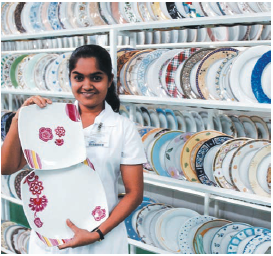
From the dental clinic she took me to a new garment showroom because I wanted to buy some readymade clothes. The showroom had threefloors. Each floor had different types of clothes. We went to the third floor where clothes for girls were kept.
Harpreet and Vandana: Businesspersons
My father and uncle worked in a small shop. During festival times and on Sundays my mother and I helped them in the shop. I started working there only after I completed my college. (Harpreet)
We opened this showroom some years ago. I'm a dress designer. Our business has changed. These days people prefer to buy readymade clothes, rather than have them stitched. The trend these days is for readymade garments. You also need an attractive display for them. (Vandana)
For our showroom, we buy things from different places. We buy most of the materials from Mumbai, Ahmedabad, Ludhiana and Tripura. Some materials also come from Noida and Gurgaon, towns near Delhi. We get some dress items from foreign countries, too.
There are several things we need to do to run this showroom properly. We advertise in various newspapers, cinema theatres, television and radio channels. Currently, this building is rented but soon, we plan to buy it. Ever since this market has become the main market for people living in the surrounding apartments our business has grown. We've been able to buy a car and book a flat in an apartment complex nearby.
Why did Harpreet and Vandana start a showroom? What do they have to do to run the showroom?
Talk to a shop owner in a market and find out how he plans his work. Have there been any changes in his business in the past twenty years?
What are the differences between those who sell on the street and those in the market?
Like Harpreet and Vandana there are many people who own shops in various markets of the city. These shops may be small or large and they sell different things. Most businesspersons manage their own shops or business. They are not employed by anyone. But, they do employ a number of other workers as supervisors and helpers. These are permanent shops that are given a licence to do business by the municipal corporation. The Municipal Corporation also decides on which dayof the week the market has to remain closed. For example the shops in thecabove market are closed on Wednesdays. This market also has small offices and shops that provide services, such as banks, courier services and others.
In the Factory-Workshop Area
I wanted to have zari work done on one of my dresses which I needed for a special occasion. My cousin said that she knew Nirmala who works in a garment factory. Nirmala's neighbours do zari work and embroidery. So we caught a bus and headed towards the factory area. The bus was really crowded. At every stop more and more people got on and hardly anyone seemed to get off. People were pushing others to make more space for themselves. My cousin guided me to a corner so that we wouldn't get squashed. I wondered how people travel like this every day. As the bus entered the factory area people started getting off. We also got off soon at a crossing. What a relief that was!
There were a large number of people sitting on railings or in groups at the crossing. They seemed to be waiting for someone. Some groups had people on scooters standing by and talking with them. My cousin explained that this place was called "labour chowk". These were daily wage labourers who work as helpers to masons. They dig at construction sites, lift loads or unload trucks in the market, dig pipelines and telephone cables and also build roads. There are thousands of such casual workers in the city.
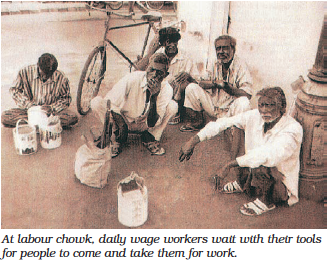
We entered the factory area to find it full of small workshops. There seemed to be endless rows of them. In one section we saw people working in a small room on sewing machines where cloth was being stitched. One person operated one sewing machine. Clothes that had been stitched were stacked on one side of the room.
We located Nirmala in the stitching unit. She was happy to meet my cousin and promised to get zari work done on my dress.
Nirmala works as a tailor in an export garment unit. The factory where she works makes summer clothes for people in foreign countries like U.S.A., U.K., Germany and the Netherlands. Workers like Nirmala have to work very long hours in the months from December to April. A normal working day begins at 9 a.m. and finishes only by 10 p.m., sometimes even later. She works for six days a week. At times when the work needs to be done urgently, she works on Sundays, too. Nirmala is paid Rs 80 a day for eight hours and Rs 40 extra for working late. By June the work is over and the factory reduces its staff. Nirmala will also be asked to leave. For about three or four months in the year, there is no work for her.
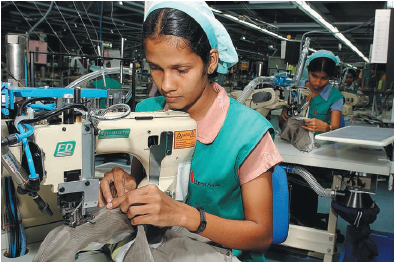
Most workers, like Nirmala, are employed on what is known as casual basis i.e. they are required to come as and when the employer needs them. They are employed when the employer gets large orders or during certain seasons. At other times of the year they have to find some other work.
Jobs like Nirmala's are not permanent. If workers complain about their pay or working conditions they are asked to leave. There is no job security or protection if there is ill treatment. They are also expected to work very long hours. For example in the cloth mill units the workers work on day and night shifts, with each shift lasting 12 hours. One worker works on one machine for 12 hours and then is replaced by another on the same machine for the next 12 hours.
1. Why do you think small workshops and factories employ casual workers?
2. Describe the working conditions of people like Nirmala keeping in mind the following: working hours, conditions in the workplace, earnings, and the days of work available.
3. Would you say that domestic workers like housemaids are also casual workers? Why? Describe the workday of one such woman detailing the work she does in other peoples' houses.
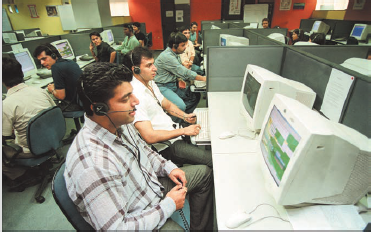
Working in Call Centres is a new form of employment in the big cities. A Call Centre is a centralised office that deals with problems and questions that consumers/customers have regarding goods purchased and services like banking, ticket booking, etc. Call Centres are generally set up as large rooms with work stations that include a computer, a telephone set and supervisor's stations. India has become a major centre not only for Indian companies but also foreign companies. They set up Call Centres here as they can get people who can speak English and will work for lower wages.
In the office area
My aunt, Sudha works as a Marketing Manager. She had asked us to reach her office before 5.30 p.m. We thought we'd get late so we took an autorickshaw that managed to get us there just in time. Her office was in an area surrounded by tall buildings. There were hundreds of people coming out. Some headed for the car park while others went towards the row of buses.
My aunt is a marketing manager in a company which manufactures biscuits. The factory where the biscuits are made is outside the city. She supervises the work of 50 salespersons who travel to different parts of the city. They get orders from shopkeepers and collect payments from them. She has divided the city into six regions and once a week she meets the salespersons of each region. She checks their progress report and discusses problems they face. She has to plan the sales in the entire city and often has to work late and travel to different places.
She gets a regular salary every month and is a permanent worker with the company. She can expect her job to continue for a long period of time. Being a permanent worker she also gets other benefits such as the following:
Savings for old age: A part of her salary is kept in a fund with the government. She will earn interest on these savings. When she retires from this job she will get this money and she can then live on that.
Holidays: She gets off on Sundays and national holidays. She also gets some days as annual leave.
Medical facilities for her family: Her company pays the medical expenses up to a certain amount for her and her family members. She gets medical leave if she falls ill and her salary is not cut if she takes this leave.
There are many workers in the city who work in offices, factories, and government departments where they are employed as regular and permanent workers.
They attend the same office or factory regularly. Their work is clearly identified. They get a regular salary. Unlike casual workers they will not be asked to leave if the factory does not have much work.
At the end of the day we got into my aunt's car, exhausted. But it had been so much fun! And I thought, how interesting that so many people do so many different things in the city. They've probably never met each other but it is their work that ties them together and helps to make up city life.
QUESTIONS
1. Read and discuss the following description of the living conditions of workers who come to the labour chowk.
Most workers that we find at the labour chowk cannot afford permanent accommodation and so sleep on pavements near the chowk, or they pay Rs 6 a night for a bed at a nearby night shelter run by the Municipal Corporation. To compensate for the lack of security, local tea and cigarette shops function as banks, moneylenders and safety lockers, all rolled into one. Most workers leave their tools at these shops for the night for safekeeping, and pass on any extra money to them. The shopkeepers keep the money safely and also offer loans to labourers in need.
Source: Aman Sethi, Hindu On-line
2. Complete the following table and discuss how their work is different:
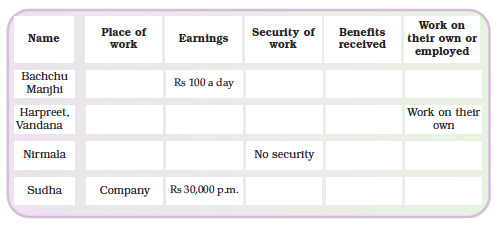
3. In what ways is a permanent and regular job different from a casual job? Discuss.
4. What benefits does Sudha get along with her salary?
5. Fill in the following table to show the services provided by people in the markets which you visit frequently.
